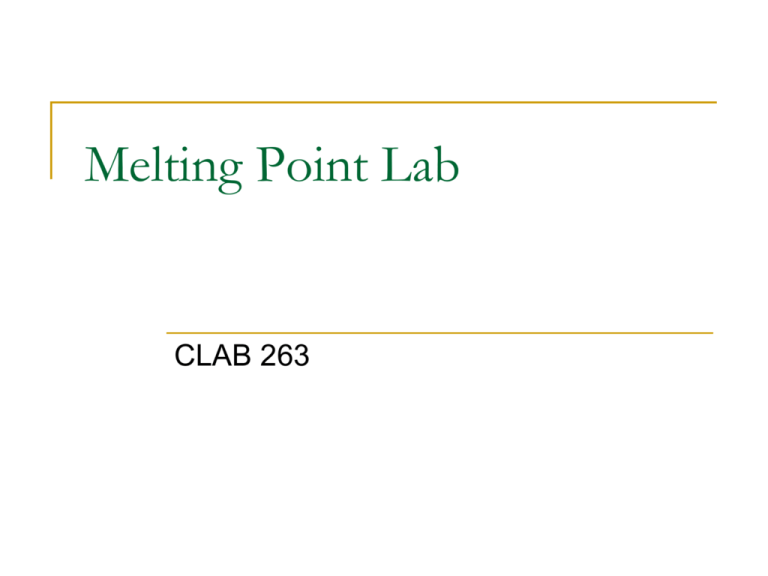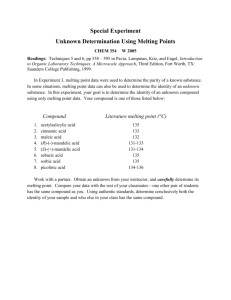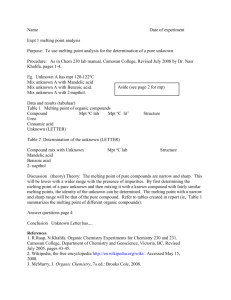Melting Point Lab
advertisement

Melting Point Lab CLAB 263 Physical and Chemical Properties All chemical compounds have both physical and chemical properties Chemical properties – how a compound or element interacts with another compound or element A change in composition of the interacting compounds occurs Example: Combustion reaction CH4 + 2 O2 CO2 + 2 H2O Photosynthesis 6 CO2 + 6 H2O C6H12O6 + 6 O2 Physical properties – can be measured or observed; no change in chemical composition Two types of physical properties: intensive and extensive Intensive – independent of the amount of material present (density, melting point, boiling point) Extensive – dependent upon the amount of material present (mass) Melting points (Freezing points) – intensive property The temperature at which a substance changes from the solid state into the liquid state. An equilibrium exists between liquid state solid state. Organic Compounds Organic compounds have a lower melting point than inorganic (ionic) compounds. Interactions between organic compounds are weaker than the ionic attraction between ions in inorganic salts. Interactions are intermolecular (between molecules) vs. intramolecular (between atoms/ions in a compound) Inorganic Salts High melting points due to the intramolecular force of attraction Not combustible due to intramolecular forces Melting points of organic compound will also vary with size and branching of the compounds Determining if a compound is organic… Combustion of Organic Compounds All organic compounds combust This property can be used to determine if a compound is organic. If a flame is applied compound burns with no residue left, compound is organic. compound doesn’t burn, it is not a carbon compound Compound burns but leaves a residue, it may be organometallic (calcium propionate, a food preservative) Observations at Melting Points The sample will appear wet. This is called sweating. Note this temperature as this is the beginning of the melting point range. With continued heat more solid will melt until no solid left only liquid. Note this temperature as this is the melting point. Melting point range – temperature range between the beginning of the melt (sweating) and the melting point. Melting Point Ranges Generally pure crystalline compounds have sharp or narrow melting point range. Two compounds can have the same melting point. Two things can affect this sharpness: Poor technique Impurities Areas that are affected by technique Size of crystals Amount of material being heated Density of packing Rate of heating Avoid adverse effects due to poor technique Size of crystals and density of packing Crystals should be small and tightly packed. This will avoid a difference in the heat applied to the sample at different points Capillary tube – use ~0.5 mm of material Hot plate apparatus – use smallest amount of material that fits into the center of the stage HEAT SLOWLY Temperature should not rise more than 1-2 oC per minute If you have a good technique and still the melting range is not narrow, your sample is probably not pure… Impurity lowers the melting point and widens the melting range! Equilibrium vapor pressure of the melt are affected by impurities just as a solute* affects the vapor pressure of a solution. *Colligative properties – vapor pressure lowering, boiling point elevation, freezing point depression, osmotic pressure Caution Melting Point Apparatus can be very hot! Capillary tubes and glass slides can be very hot! Place all used capillary tubes in Glass Disposal Box. Allow the melting point apparatus to cool at least 10o below the observed melting point of your compound before repeating procedure. TODAY Get a melting point on pure benzoic acid, fast ramp, then a slow ramp. Unknown – Get a “fast” melting point, b/c this will allow you to have a general idea what the melting point is. Allow the apparatus to cool to approximately 10o below the initial sweat. Then repeat SLOWLY two times. Get a melting point on impure benzoic acid, fast then slow.




